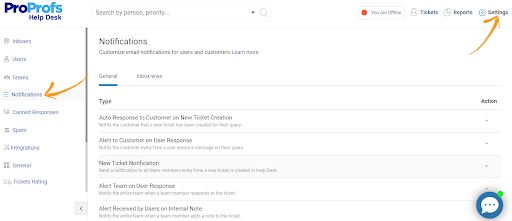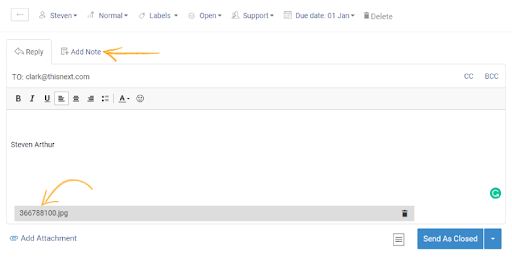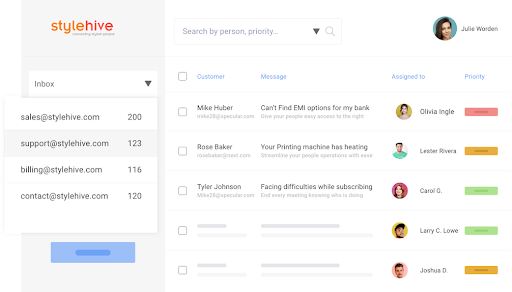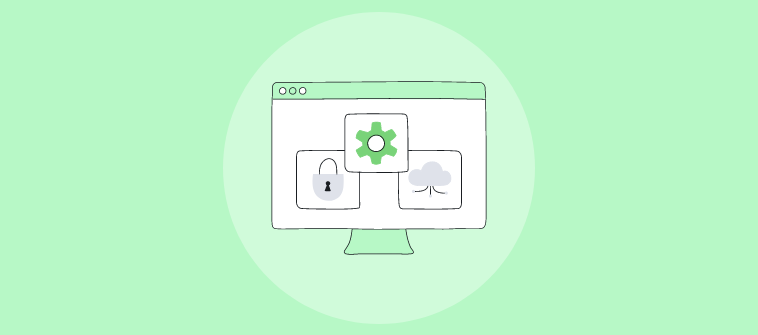‘Moving to the Cloud’ has become a popular strategy most businesses embrace.
With more and more brands seeking cost-effective and efficient ways to manage customer service processes, the demand for cloud-based help desk systems has been on the rise.
Implementing a cloud-based ticketing system can prove to be just the right move for your team. You can enjoy benefits such as anytime and anywhere access, data security, automated backups, flexible pricing, and high scalability.
But there is a challenge!
Most people have no idea about the difference between on-premise and cloud help desks. If you are sailing in the same boat, we are here to help.
In this blog, we will understand how a cloud help desk works. Later, we will explore the 10 benefits that your business can enjoy after implementing this system.
Let’s go!
What Is a Cloud-Based Help Desk?
A cloud-based help desk system is a popular business tool that can be accessed by customer service teams over the internet using any web browser. The cloud help desk helps you avoid the burden of self-hosting and helps you keep track of all your customer conversations in one place.
It is common for companies to have distributed teams spread across the globe. In such a situation, installing servers and purchasing a license for these locations can be expensive. As a wonderful alternative, cloud-based ticketing solutions have allowed teams to operate from any part of the planet.
Support agents can interact with customers via email, phone, or live chat, prioritize urgent tickets, collaborate with other departments, and offer delightful support.
How Does a Cloud-Based Help Desk Work?
The lifecycle of a support ticket starts when a customer raises an issue and ends when it is marked as resolved. The below steps will explain how a cloud-based ticketing solution works:
Step 1: It all starts when a customer registers an issue or makes a request via any active communication channel – email, phone, live chat, etc. In most cases, the customer can also choose to raise a ticket contact us page or online help center.

Step 2: As soon as the message lands in your help desk inbox, it is created into a new ticket. Agents can receive New Ticket Notification via email so they can start working on it immediately.

Step 3: Agents can access the ticket from anywhere using a phone, PC, or laptop. They can either choose to assign tickets manually or automate the process using the round-robin method.
Step 4: Once a ticket is assigned to a relevant owner, they can perform certain actions such as:
- Mark the priority of the ticket as High, Low, or Normal
- Share an appropriate solution with the customer
- Discuss the issue with the team members using private notes
Step 5: In this final step, the agent shares a solution with the customer and marks the ticket as resolved. An automated survey is shared with the customer to rate their satisfaction with the support interaction.
What Are the Advantages of Using Cloud-Based Help Desk Software?
Right from accessibility to high security, there are multiple advantages that these tools bring to the table. Here are the top 10 cloud-based help desk benefits that you need to know:
1. Get a Holistic View of Support Tickets
If you use different tools to handle different communication channels, such as email or live chat, things can get confusing quickly. While keeping track of emails, you might lose track of chats and vice-versa.
With cloud-based help desk software, you can streamline your ticket management process. Agents can easily view tickets from email, live chat, web forms, phone, social media, etc., in one place.
When all tickets can be tracked from a single dashboard, agents can easily monitor progress and plan their tasks accordingly. Moreover, you can filter tickets using Labels, Priorities, and Inboxes.
2. Enjoy Anytime, Anywhere Access
Unlike its on-premise counterpart, cloud-based systems offer anytime, anywhere access. But what exactly does that mean?
Whether your support representatives operate from the office or home, they can access the platform from anywhere. All they need is a device (laptop, mobile, PC) and an internet connection.
In the case of on-premise systems, the servers are installed within office premises, and agents can only access them when they are in the office. However, with cloud-based tools, the entire data and backups are stored securely on the cloud. This means you can enjoy anytime, anywhere access and no stressing over retrieving data.
3. No Need to Worry About Backups or Security
When you choose this software system, you do not have to worry about data security or backups. All these aspects are taken care of by the vendor.
The software vendor is responsible for managing different aspects of the software lifecycle. For instance, they take care of data security, automated backups, and maintenance.
This means you do not need to hire additional people to manage your data or maintain your servers. Your customer service team can focus on what they do best – deliver delightful customer experiences.
4. Receive Timely Software Updates
Does your help desk software lag too often? Do you wish it had a better interface or offered the latest features? Don’t worry; you are not alone.
Vendors of a cloud service desk have a development team that works day in and day out to ensure the best software is offered to you. They frequently test and launch updates to ensure your support team can work without any glitches.
When you opt for an on-premise system, you are stuck with the same features and interface for years. You will have to hire a third-party company or software developers to make the changes according to your needs. Therefore, it’s best to use a cloud-based tool that offers automated and regular updates to ensure your team can achieve its goals.
5. Improve Collaboration With a Shared Inbox
With a shared inbox, you can manage multiple team inboxes, such as support@company, returns@company, info@company, etc., in one place. This saves agents a lot of time they would otherwise spend sharing login credentials with each other.
The shared inbox feature offers multiple capabilities to enable real-time internal collaboration. Internal notes, agent collision detection, parent-child ticketing, and so on.
Let’s discuss a little bit about these team collaboration features:
Agents can add internal notes to tickets to discuss complex issues together or offer context to new agents. With the collision detection feature, agents can see who is working on what and avoid sharing duplicate replies with customers. You can even break a complex support ticket down into multiple child tickets and delegate them to different departments.
Read More: 10 Shared Inbox Best Practices For Email Success
6. Integrate With Multiple Cloud-Based Tools
A cloud-based help desk system can easily integrate with popular tools, including cloud ETL tools, which can help streamline data workflows. You can enhance team collaboration and customer experience by connecting the help desk with your existing tool stack.
When it comes to integrations, the more, the merrier. Right more CRM to project management to e-commerce tools, you can enjoy multiple integration options.
Powerful integrations can help your team automate workflows and allow different departments, such as sales, marketing, or product development, to communicate with the customer service team.
For example, you can integrate your help desk with a CRM tool to allow support reps to access complete customer information. They can view a customer’s interest, past orders, etc., and use this information to personalize the experience.
7. Customize Your Tool to Match Your Unique Needs
Customization is considered a top cloud-based help desk advantage.
Multiple customization options can help you mold your help desk as per your unique needs. Right from the look and feel of your dashboard to ticketing workflows, there is a lot you can do to make your cloud help desk your own.
When it comes to customization options, there is simply no limit. Different tools can help you customize different aspects of your ticketing system. For example, you can filter your reports to view the metrics that are important to your business goals and objectives.
You can even customize the different elements of your live chat window – the placement or position of the chat window, color, icon size, text, language, and a lot more. Moreover, you can even personalize the chat greeting message to enhance the visitor experience.
Read More: 10 Ways to Customize Your Help Desk Software
8. Enjoy Robust Customer Support
When you choose an on-site help desk, customer support can be a significant concern. You will either have to hire additional IT support people or wait for the vendor to send their team (which can be quite expensive).
Most cloud-based ticketing systems come with awesome, 24×7 support. Most companies have their own customer support team trained to help you with everything from software deployment to upgrading your plans.
Depending on the urgency, you may choose to contact the company via phone, email, chat, or simply drop a request on their website. You can even access their vast help center, which includes a repository of FAQ pages, knowledge base articles, getting started videos, and other useful content.
9. Flexible Pricing
Pricing is another big factor that will convince you to go for cloud-based software. They usually follow a subscription-based model, which charges you monthly or annually.
With a cloud-based help desk, you can enjoy flexible pay-per-user plans. You can choose any plan and pay only for the features that your team needs.
In the case of on-premise versions, you are required to make a heavy, one-time payment. This might not be an affordable option for startups or small businesses that have a limited budget.
In addition to this, most cloud-based tools even offer a free trial (anywhere from 7-30 days). During your trial period, you can evaluate the different features and see if the tool can actually fit your needs.
10. Scalability
Another benefit of cloud-based help desk tools is that they are highly scalable. You can always opt for a suitable plan as and when your business grows.
Scalability should be a priority whenever you are looking for software for your team. Even when your customer base expands and your team grows, the same tool should be able to meet your growing needs.
For example, if you are a startup or small business, you can opt for a basic plan that costs less but offers more or less all the basic ticketing features you will need. On the other hand, if you are a large company or an enterprise, you can opt for the top-tier plan to enjoy advanced automation and customization capabilities.
Ready to Move Your Help Desk to the Cloud?
The post-pandemic era demands customer service teams to quickly adapt to the new normal and deliver support through a collaborative effort. With cloud-based help desk software, your office and remote employees can work together without any hassles.
Compared to its on-premise counterpart, there are multiple cloud-based help desk advantages that you can look forward to. For example, your team can enjoy 24×7 accessibility, better internal collaboration, data security, flexible pricing, and other benefits.
If you are looking for an affordable cloud-based solution, look no further. ProProfs Help Desk offers seamless ticket management, powerful automation, and 24×7, secure accessibility. Ready to move your help desk to the cloud and delight customers?
 Tips
Tips
We’d love to hear your tips & suggestions on this article!
FREE. All Features. FOREVER!
Try our Forever FREE account with all premium features!




 We'd love your feedback!
We'd love your feedback! Thanks for your feedback!
Thanks for your feedback!







